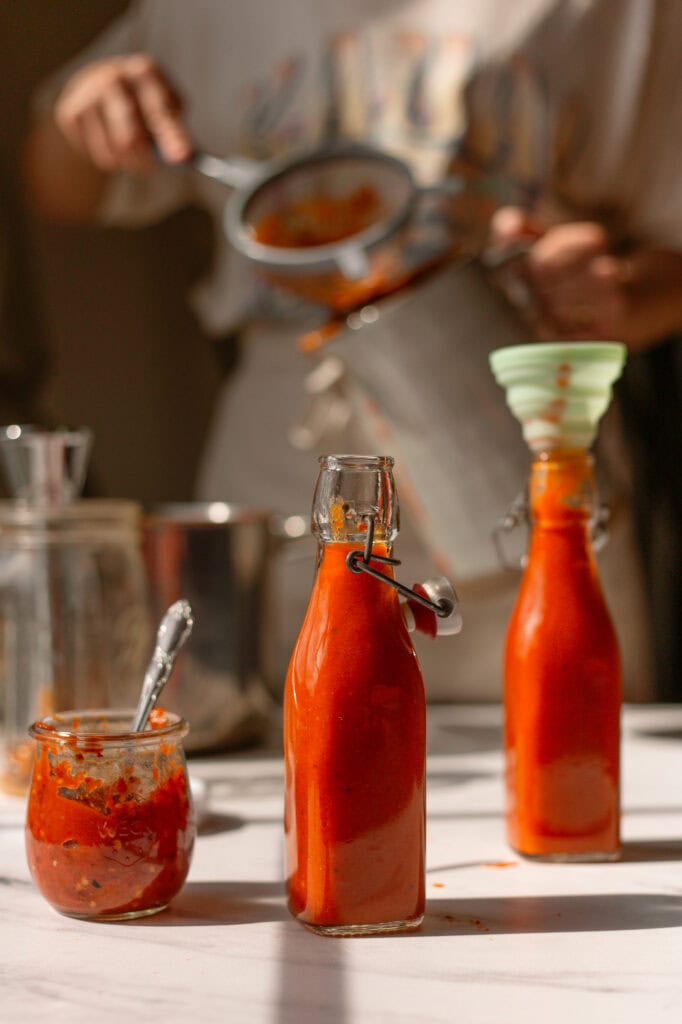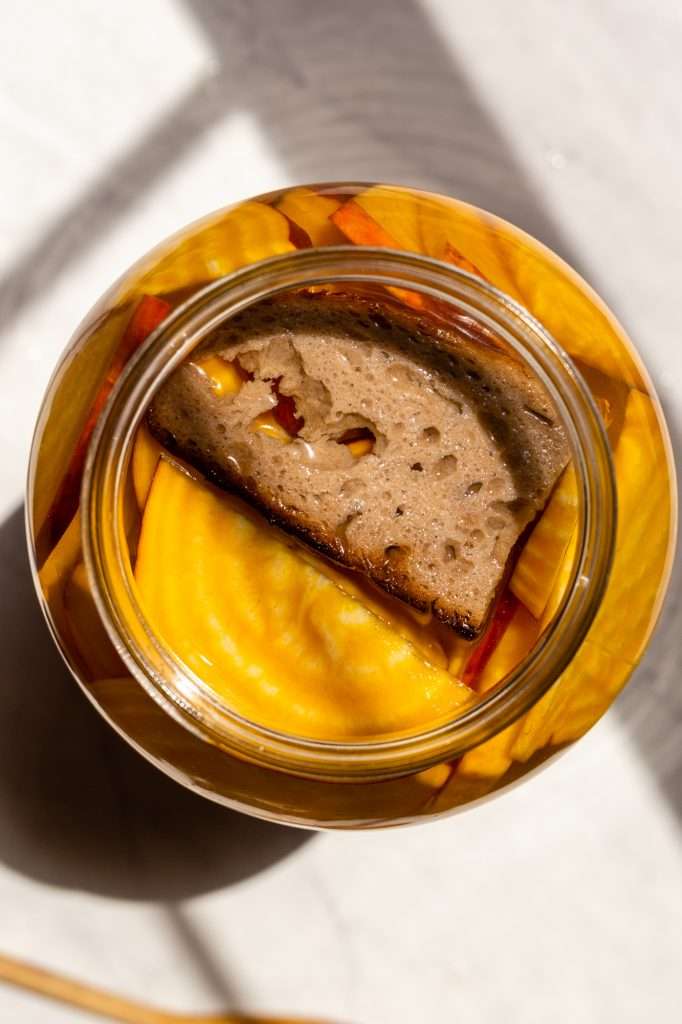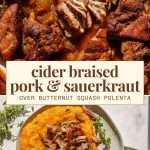The Perfect Pork and Sauerkraut for New Years
Eating pork and sauerkraut on New Year’s Day is a tradition. I believe it brings good luck and prosperity, with pork symbolizing progress and sauerkraut representing health and longevity.
Pairing this dish with roasted butternut squash polenta adds a sophisticated touch. The pairing makes it special for holiday celebrations while remaining hearty for winter.
With its winter ingredients like sauerkraut, cider, and butternut squash, this dish offers rich flavors and essential nutrients. Sauerkraut is high in Vitamin C, boosting the immune system, while roasted butternut squash provides Vitamin A and antioxidants. The combination of cider-braised pork, tangy sauerkraut, and creamy polenta creates a delightful and satisfying meal to welcome the New Year.

What is the tradition of pork and sauerkraut?
There is a long-standing tradition of eating pork and sauerkraut, especially in German, Eastern European, and American cultures, particularly on New Year’s Day. This dish is believed to bring good luck and prosperity for the coming year, and it is rooted in various cultural beliefs.
In Germany and Eastern Europe, pork symbolizes wealth and progress, as pigs root forward, representing advancement. Sauerkraut, made from fermented cabbage, has been a winter staple due to its preservation qualities, providing essential nutrients when fresh produce is limited.
On New Year’s Day, consuming pork and sauerkraut is customary in these cultures, with the idea that it promotes good health and good fortune. Some incorporate specific types of cabbage for their historical significance as nourishing foods during hard times.
This tradition was brought to the U.S. by German immigrants, particularly in Pennsylvania, Ohio, and Michigan. It remains a popular dish on New Year’s Day, symbolizing the hope for a successful year ahead.
Overall, pork and sauerkraut are enjoyed for both their practical benefits and symbolic meanings of health and prosperity.

The best cuts of pork to use for braising
Braising is a fantastic method for cooking pork, especially when you choose cuts that benefit from slow, moist cooking. The best braising cuts are typically tougher and have more connective tissue, as they become incredibly tender and flavorful after long cooking. Popular choices include pork shoulder, pork belly, and pork ribs, which all have the right balance of fat and muscle to break down and become juicy and tender.
However, I like to cut up a pork loin roast and use that. It works wonderfully when cubed and seared in butter, tallow, or lard. While it’s leaner than other cuts of pork, when braised properly, it stays moist and absorbs the flavors of the braising liquid, yielding a delicious melt-in-your-mouth result. I love braising this cut in this recipe; it’s my favorite for the dish.


Cider Braised Pork and Sauerkraut
Flavor Complexity: Both cider and sauerkraut add depth to the dish. The cider contributes subtle sweetness and tartness, while the sauerkraut provides tangy umami notes.
Tenderizing Effect: The acidity in both cider and sauerkraut helps break down the pork’s connective tissue, resulting in a tender, melt-in-your-mouth texture.

Health Benefits: Sauerkraut, even when cooked, retains its beneficial postbiotic compounds, vitamins, and fiber. Meanwhile, cider adds antioxidants and is a lighter option for braising liquids.
Together, cider and sauerkraut not only enhance the flavor of braised pork but also offer a combination of health benefits, making the dish both delicious and nourishing.


What do you eat with pork and sauerkraut?
Pork braised with cider and sauerkraut offers a delightful combination of tender, savory meat, and tangy sauerkraut, balanced by the subtle sweetness of the cider. I compliment this hearty dish with creamy butternut squash polenta, made by mashing roasted butternut squash into cooked polenta.

The natural sweetness of the squash balances the richness of the pork and the sharpness of the sauerkraut, while the creamy texture of the polenta adds depth.

This rustic and sophisticated pairing makes it a perfect comforting meal for winter or fall.

Tips for making this recipe with ease
- Roast the squash first and set aside before you begin anything else!
- Check halfway through cooking with the lid on and add more water if needed.
- Prepare the polenta while the pork and sauerkraut are braising for the most efficient timing.
Homemade fermented ingredients in this recipe

Things You May Need:
Print
Cider Braised Pork and Sauerkraut Over Butternut Squash Polenta
Cider braised pork and sauerkraut is a perfect choice for New Year’s or any winter meal. Paired with butternut squash polenta, it’s packed with vitamin C and warm, comforting flavors.
- Prep: 25 minutes
- Cook: 120 minutes
- Total Time: 2 hours 25 minutes
Ingredients
- 3 lbs pork loin roast
- 2 tablespoons butter (or tallow or lard)
- salt
- black pepper
- 1 cup hard cider (pear or apple)
- 1 cup sauerkraut with brine
- 2 tablespoons vinegar
- 2 tablespoons maple syrup (or honey)
- 3 cups water
- 2 shallots, minced
- 8 garlic cloves, minced
- 1 sprig fresh rosemary
- 1 sprig fresh thyme
- 2 cups polenta (for the polenta)
- 6 cups water (for the polenta)
- 1 medium butternut squash (for the polenta)
- salt (for the polenta)
Instructions
- Before you begin with the braise, roast the butternut squash. Doing this first makes the whole process super easy. Cut the squash in half, remove the seeds, rub with a little olive oil and roast open side down on a sheet pan in the oven at 400°F for an hour. Once it’s finished set it aside until cool, then remove the skin.
- Next prepare the braised pork.
- Preheat your oven to 375° F.
- Cube the pork loin roast into large chunks. Pat dry with a paper towel and season generously with salt and pepper.
- Heat the 2 tablespoons of butter in a cast iron pot (make sure it’s one with a lid that can go in the oven).
- Once your pot and the butter are very hot, sear the pork on both sides.
- Once the pork is seared, pour in the apple cider to deglaze the pan. Add the sauerkraut and let it simmer for about 3 minutes.
- Add in the vinegar, maple syrup, water, shallots, and garlic. Give it a stir, and add in the fresh rosemary and thyme.
- Place the lid on the pot and place it in the oven. Cook with the lid on for 90 minutes. (Check half way through to make sure there is still enough liquid in the pot, if not add a bit more water).
- After 90 minutes, remove the lid and cook with the lid off for another 30 minutes.
- While the braised pork is in the oven, prepare the polenta.
- Bring 6 cups of water to a boil. Whisk in 2 cups of polenta, and reduce the heat to a simmer.
- Cook for about 5-7 minutes with frequent stirring, until all the water is absorbed.
- Mash the roasted butternut squash into the polenta until smooth. Salt to taste. (Optional: add in some butter and cheese)
- Plate 1 cup of polenta and top with the braised pork, a drizzle of braising liquid, and some fresh thyme.























Yummo! In Italy we eat cotechino (pork) and lentils for Capodanno (new year)
Delicious, easy, healthy… awesome recipe! I made it in the slow cooker and swapped the squash with summer veggies for summer one as I’ in the southern hemisphere 🙂 . Perfect still!
oh yum! I’ll definitely give it a try with summer veggies when it’s summer here again. Thank you for trying my recipe and leaving a review!
I like this website but the content is so hard to see because of all the popup ads. I hope the owners are getting a significant amount of money for this irritation.
Glad you like the website! We use a minimal amount of ads compared to the average blog so that we can give you these recipes for free. Isn’t it so nice that you don’t have to pay anything at all for my hard work?
This is so easy and tasty. I’m making it for the second time tonight.